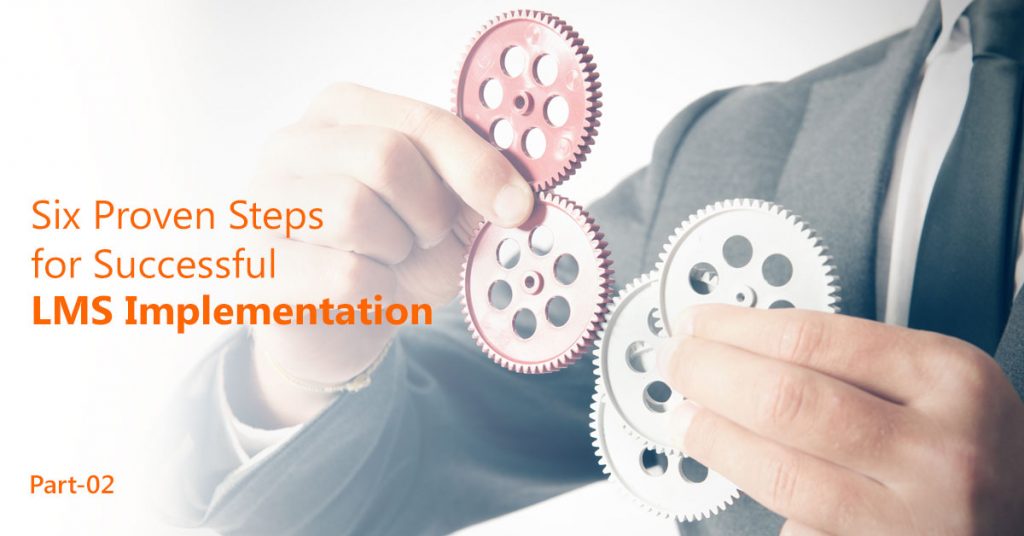On this Page
Six Proven Steps for Successful LMS Implementation
Migration to a new LMS and its implementation can be a disruptive and complex process if a proper process is not followed. Hence, after the first step of planning which we discussed in our previous blog, we will now understand how the second step, i.e. Configuration of an LMS can be done.
Having a plan for the implementation of your LMS will give you a clear idea of the necessary tasks you must include during configuration. Configuration involves multiple stages. Your LMS vendor may or may not be able to provide you with all the tasks that your business may require in an LMS. Hence, make use of your vendor’s expertise with their product and your own core team’s expertise and align it with your organization’s needs. Mutually decide the tasks and produce the best possible outcome to configure. This decision will involve paying attention to the understanding of your data and operations, and a clear and in-depth understanding of the system’s data fields, functionalities, and capabilities.
Here are a few things you must consider when configuring your LMS:
User profiles
Identify the demographic data you will require, where it is currently stored and managed, and where you can store it in the LMS. For a corporate LMS, the demographic data will include fields like the user’s name, contact information, job function, designation, their manager, employment status, date of joining, department, etc.
Domain and audiences
For organizations who plan to train their employees and customers, having an LMS that allows you to configure multiple domains is recommended. This way, you can put the employee user accounts, internal training courses/programs and administrators in a single domain, and keep the customers, external course material, and another set of administrators in another domain. This way you can have two LMSes installed for the price of one, and at the same time, manage both separately at ease. Within a domain, an LMS can enable you to configure audiences based on their profile information while some LMSes may also enable you to restrict visibility of courses to a certain set of audience based on their training requirements.
Administrator security roles
This includes a set of permissions that are assigned to each type of administrator of the LMS. For example, you may require one administrator to manage reports, one to create and schedule courses for the learners, and one to manage registrations. To have multiple administrators, you will first establish three security roles and configure the necessary permissions for each of these roles and then you can assign a user to these roles.
Some LMSes may also allow you to assign multiple roles to a single user with defined permissions for each role. And, in LMSes that support multiple domains, you can assign different roles to a user in each domain.
Catalog of courses and metadata
An LMS catalog is nothing but a menu-driven way to enable learners to explore courses offered in the system. So, you need to design a catalog considering the courses you are offering to your learners. The catalog will comprise a menu structure which will be associated with its respective catalog nodes. Metadata are the properties or tags that are assigned to describe courses. These metadata tags are of great importance for end users while they search for any particular course using these attributes/descriptions.
Structure of course curriculum
Defining a course curriculum is crucial in identifying various activities involved in each course like enabling learners to pick their own activities from the courses and get trained in a sequence if needed, as per their convenience. For example, a course may include multiple learning activities such as pre-tests, reading assignments, a self-paced module, attendance of a webinar session, and a survey. Some of these may be mandatory, while others may be optional. Hence, each combination of these activities needs to be considered while framing the structure of the course.
The curriculum will have a certain number of courses in any sequence and the credits of curriculum completion will also vary from curriculum to curriculum. So, it is important to understand that these curriculum structures can be configured properly only when the course data is migrated from the legacy system to the new LMS.
Evaluation and assessments
A majority of LMS products today have built-in tools for evaluation/survey and assessment/test. A native LMS tool helps you in viewing reports at the question level thereby enabling you to perform item analysis and determine the validity of the survey or the test. On the other hand, a disadvantage of using a native LMS tool is that if you plan to switch to an LMS later, you may need to redevelop the entire assessment data. And, if you are using a third-party testing tool, try to find out how the tool interoperates with the LMS. Your tool and LMS vendors can help you with these details and functionalities.
Competencies
An LMS allows you to create a list of competencies and a proficiency scale that is applicable to any competency. The proficiency scale for a user may vary from one competency to another. Likewise, these competencies are then associated with jobs, assessments, and courses. So, if a user does not have adequate proficiency in all the required competencies, courses to develop those skills and knowledge are then recommended. Competencies can be configured by entering the competencies and proficiency scale, and associating competencies with jobs, assessments, and courses.
Notifications
Some LMSes offer out-of-the-box notifications while some allow clients to create custom notifications. Notifications are helpful to remind learners of their training classes and assignments too. To configure notifications, you must decide which ones to activate and which ones to deactivate. This way you will avoid spamming your learners with unnecessary notifications.
Reports
There are some LMSes which provide out-of-the-box reports while some include reporting tools that enable you to configure custom reports. Some of these also have advanced options to add graphical reports, dashboards, pivot tables, etc. Defining report requirements is very crucial in the early stages of the implementation process. So, here you may need to collate a list of all the reports that you need, for whom, the frequency, and what set of information/data is visible, and in which format. All these details matter as the report requirements will guide many of your LMS configuration and data migration decisions. Some LMSes also allow you to schedule reports which are then directly emailed to the list of recipients in Excel or PDF format, as defined by you.
The next step to successful implementation of an LMS after configuration is the integration of an LMS. Come back to know more about this in our upcoming blog. If you have any queries about LMS implementation, you can connect with us on Facebook, LinkedIn or Twitter. To get a free trial of Abara LMS, contact us today.

